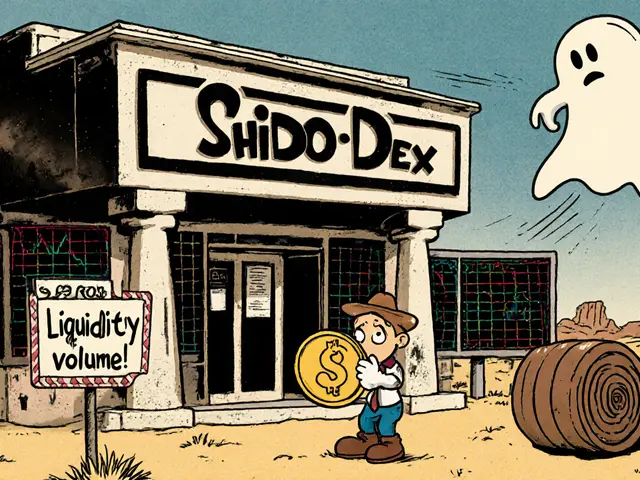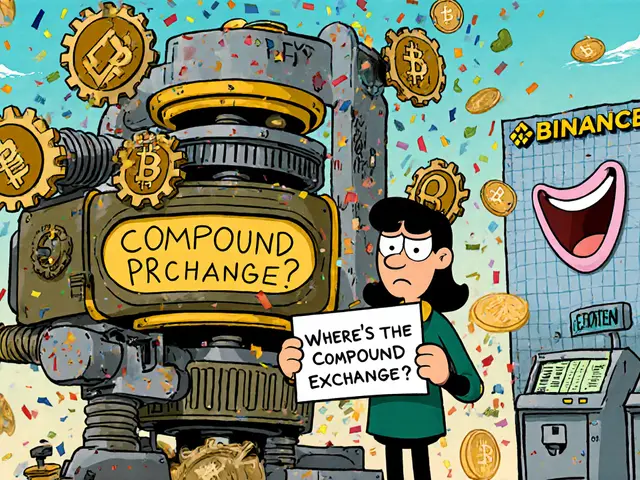
Crypto Derivatives 2025 Market Impact Calculator
Enter values and click "Analyze Market Impact" to see projected outcomes
Key Takeaways
- Monthly crypto derivatives volume hit $8.94trillion in 2025, driven by Bitcoin and Ethereum contracts.
- Centralized exchanges still dominate, but DeFi platforms like dYdX are closing the liquidity gap.
- The Trump administration’s pro‑crypto executive orders have reduced regulatory uncertainty in the U.S.
- Security breaches and extreme market crashes remain the biggest headwinds.
- Expect more crypto‑based ETFs, tax‑friendly treatment, and hybrid products that blend traditional finance with DeFi.
When talking about the next wave of digital finance, crypto derivatives are financial contracts whose value is derived from underlying cryptocurrencies such as Bitcoin or Ethereum, allowing traders to hedge, speculate, or gain exposure without holding the asset directly. By the end of 2024 the global derivatives market topped USD700trillion in notional value, and crypto‑linked contracts alone were estimated between USD20trillion and USD28trillion. That massive size, combined with a surge in institutional interest, makes the future of crypto derivatives a must‑watch topic for anyone involved in digital assets.
1. Market Snapshot - 2025 in Numbers
Here’s the hard data that shapes the conversation today:
- Monthly trading volume: $8.94trillion (up 12% YoY).
- Bitcoin & Ethereum together represent ~68% of all crypto derivative contracts.
- Open interest in Bitcoin options exceeded $4billion in Q22025.
- Ether options daily volume rose 65% from 2024 to 2025.
These figures tell a simple story - the market is no longer a niche playground for retail speculators; it’s becoming a core risk‑management tool for large‑scale investors.
2. Product Landscape - From Futures to Ever‑lasting Options
Derivatives come in many shapes. The most common categories are:
- Futures - standardized contracts that settle daily.
- Options - give the right, not the obligation, to buy or sell at a preset strike.
- Perpetual swaps - futures without an expiry date, funded by periodic payments.
- Non‑deliverable forwards (NDFs) - settle in fiat, popular for jurisdictions with capital controls.
- Ever‑lasting options - a DeFi‑native experiment that removes a fixed expiry, letting the holder exercise at any time.
Innovation is accelerating. Crypto.com’s “UpDown” options let traders bet on price direction without specifying a strike, while FalconX’s staking‑yield swaps turn staking rewards into tradable contracts. These hybrid products blur the lines between traditional finance and decentralized finance, opening new arbitrage opportunities.
3. Centralized vs Decentralized Platforms
Both models have matured, but they serve different trader segments. Below is a quick side‑by‑side view:
| Aspect | Centralized Exchanges | Decentralized Protocols |
|---|---|---|
| Liquidity | Deep, institutional‑grade (Deribit, CME) | Growing, but fragmented (dYdX, Perpetual Protocol) |
| Regulatory Oversight | Subject to national regulators (SEC, FCA) | Code‑based, limited direct oversight |
| Counterparty Risk | Managed by exchange’s margin system | Smart‑contract risk; mitigated by audits |
| Custody | Customer assets held by the exchange (hot & cold wallets) | User retains custody; trades settle on‑chain |
| Product Variety | Futures, options, swaps, ETFs | Perpetuals, NDFs, ever‑lasting options |
In the United States, the Chicago Mercantile Exchange (CME) still holds over 60% of monthly crypto futures volume, but the rise of DeFi protocols means traders can now access comparable products without a broker‑dealer license.

4. The Regulatory Upside - Why 2025 Feels Different
U.S. policy swung dramatically after President Donald Trump’s inauguration on January202025. Within days, Executive Order14178 declared America a “Bitcoin superpower,” followed by a series of pro‑crypto measures:
- Creation of a strategic Bitcoin reserve and a digital‑asset stockpile.
- Permission for employer‑sponsored retirement plans to hold crypto assets.
- Revocation of the previous administration’s restrictive guidelines, effectively clearing a path for crypto ETFs.
One concrete win came on February192025 when the Securities and Exchange Commission (SEC) dropped its appeal against a court ruling that had overturned the “Dealer Rule,” a regulation that previously threatened DeFi liquidity providers. The decision removed a major cloud of uncertainty over decentralized market makers.
On January302025, the SEC also approved Bitwise’s combined Bitcoin‑Ethereum ETF, further legitimizing crypto exposure for traditional investors. These moves have encouraged banks, hedge funds, and asset managers to allocate capital to crypto derivatives, boosting both volume and open interest.
5. Security, Volatility, and Risk Management
Growth isn’t without pain. Two high‑profile events in early 2025 illustrate the fragility of the ecosystem:
- In late January, Phemex suffered a hot‑wallet breach that siphoned between $70million and $85million, allegedly by North Korea’s Lazarus Group. The incident forced temporary withdrawal halts across several exchanges.
- On February3, a geopolitical shock triggered a market crash that liquidated $2.2billion in crypto futures in 24hours, with Bitcoin and Ethereum futures alone wiping out $409million and $600million respectively.
These events highlight three core risk vectors:
- Operational security - hot‑wallet practices, multi‑sig custody, and regular audits are non‑negotiable.
- Leverage exposure - high‑frequency liquidations can cascade quickly; using modest leverage (≤5×) can reduce blow‑outs.
- Regulatory shock - policy swings can affect margin requirements and market access overnight.
Smart risk‑management frameworks now combine traditional VaR models with on‑chain analytics that track liquidations, funding rates, and open interest in real time.
6. Looking Ahead - Trends Shaping 2026 and Beyond
Four megatrends will define the next phase of crypto derivatives:
- Hybrid ETF‑Derivatives Products - Expect more funds that bundle spot holdings with futures or options, providing a single‑ticket exposure.
- Tax‑Friendly Infrastructure - Several jurisdictions (e.g., Singapore, Switzerland) are introducing clearer tax codes for crypto trades, making the market more attractive to high‑net‑worth individuals.
- DeFi‑Centric Liquidity Pools - Protocols like dYdX are launching “liquidity mining” programs that reward market makers with native tokens, boosting depth on decentralized order books.
- Cross‑Asset Integration - Traditional banks are piloting futures contracts that settle in tokenized stocks or real‑world assets (e.g., gold‑backed tokens), blurring the line between crypto and conventional markets.
Data providers are also stepping up. Aggregated options metrics-including implied volatility surfaces, skew, and Greeks-are now available from multiple vendors, giving traders the analytical depth previously reserved for equity options.
7. How to Participate - A Practical Checklist
If you’re ready to dip your toes-or dive-in, follow this short guide:
- Choose the right venue: For deep liquidity in Bitcoin options, consider Deribit or CME. For DeFi exposure, connect a wallet to dYdX or Perpetual Protocol.
- Secure your keys: Use hardware wallets for any on‑chain positions, and enable 2FA on centralized accounts.
- Define risk limits: Set a maximum notional exposure (e.g., 5% of total portfolio) and stick to it.
- Use appropriate contracts: Beginners may start with low‑leverage futures; seasoned traders can explore options strategies like straddles or covered calls.
- Stay compliant: Check your jurisdiction’s tax treatment. In the U.S., the 2025 IRS guidance treats crypto derivatives as capital assets, but reporting requirements differ by contract type.
By following these steps, you’ll be better positioned to capture upside while mitigating the downside that still characterizes this fast‑moving space.
Frequently Asked Questions
What are crypto derivatives and how do they differ from spot crypto trading?
Crypto derivatives are contracts whose value comes from an underlying cryptocurrency. Unlike buying the crypto itself (spot), derivatives let you speculate on price moves, hedge exposure, or gain leverage without actually owning the asset.
Which platforms offer the deepest Bitcoin options liquidity?
Deribit leads the market, followed by CME for regulated U.S. traders. Decentralized options on dYdX are growing but still trail in total volume.
How have U.S. regulations changed for crypto derivatives in 2025?
Executive Order14178 and subsequent policies removed several barriers: the SEC approved a Bitcoin‑Ethereum ETF, the “Dealer Rule” was repealed, and retirement‑plan crypto holdings are now permissible.
What are the biggest security risks for crypto derivatives traders?
Hot‑wallet hacks, smart‑contract bugs on DeFi platforms, and rapid liquidations during market crashes. Using hardware wallets, audited contracts, and modest leverage mitigates these risks.
Can I trade crypto derivatives tax‑free?
No jurisdiction offers a completely tax‑free regime for derivatives. However, some countries (e.g., Singapore) provide favorable capital‑gain treatment, and the 2025 U.S. IRS guidance clarifies reporting but still taxes gains.





